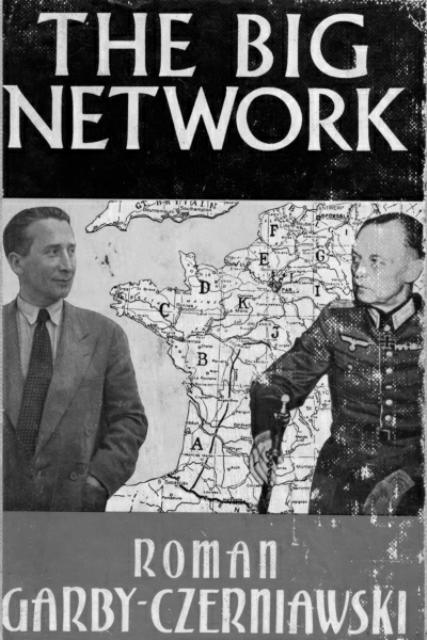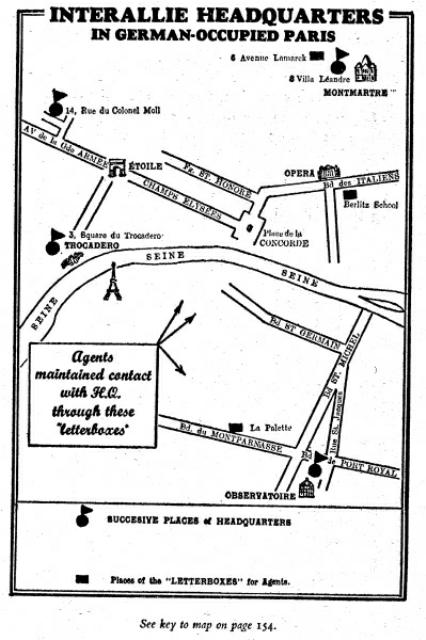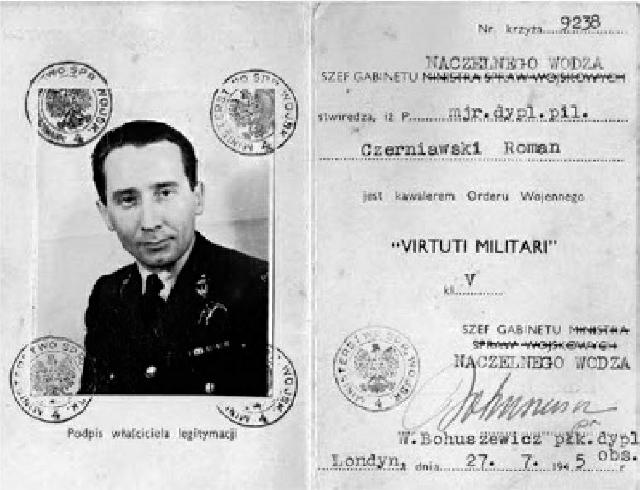| Marcus Junius Brutus, (June 85 BC to October 42 BC), one of the leading conspirators against Caesar’s growing tyranny, became famous in March 44 BC when he participated in the killing of Julius Caesar. This Brutus was a politician and senator of Roman noble birth, and thus NOT Polish. The Polish ‘Roman’ operated in World War II as an Allied agent using the pseudonym ‘Brutus’; he was an intensely patriotic Polish air force officer who repeatedly risked his life fighting most effectively for ‘your freedom and ours’.
Roman Garby-Czerniawski (6th February, 1910 to 26th April, 1985) was the most productive and important Allied agent of World War II. Not only was he one of the top two contributors to the superbly successful strategic deception of the Germans in the 1944 Normandy campaign, but in the early stages of the conflict, after the Germans had annihilated the Allied armies in France, he organised and ran Interallie, the first, best and most comprehensive espionage network across France.
At a time when the Nazis were preparing Operation Sea Lion, the invasion of Britain, Czerniawski’s Big Network of more than one hundred and sixty agents divided into fourteen sectors, provided the Polish and British governments in London, accurate information of the German order of battle down to the Company level of each division. Interallie provided particulars of train timetables, German troop movements, fortifications, coastal batteries and mapped the location of landing fields, naval installations, radar sites and fuel dumps etc.
Czerniawski, one of the world’s great warriors, a man who contributed so much to Allied victory is not famous in Poland (yet)! This is odd because Polish people are generally well versed in the lives of their World War II heroes. Oddly too, he seems to be better known in the English speaking world where ignorance of Polish heroism is common! Things are beginning to change now that MI5 has begun to release its secret archives and this has opened the doors for historians to research the British Double Cross system.
Roman Garby-Czerniawski began his military career after graduating from Aviation Cadet School in Deblin in 1931. He worked his way through the ranks and, after two years of advanced military training at Poland’s prestigious Wyższa Szkoła Wojenna, in 1938 Roman was promoted to Captain in the Organisation Department of the Polish Air Force Headquarters in Warsaw. In 1939, shortly after Germany invaded from the west, Czerniawski was instructed to organise the air force Defence Command of Lublin using whatever planes were left in Warsaw. Poland couldn’t fight two powerful enemies at the same time so when the Soviets invaded from the east he was ordered to get the aircraft to Romania. To avoid being interned by the Romanian government, the strongly patriotic Czerniawski was able to escape - via Yugoslavia and Italy - to Paris where Polish forces were regrouping to continue the fight.

|
Between November of 1939 and March of 1940 he honed his skills in military intelligence at the Paris Military School and shortly after he was put in charge of Intelligence in the Polish First Division. Czerniawski took part in the fighting against the Germans in the Alsace Lorraine district. When his unit was disbanded, after France collapsed, General Duch ordered Czerniawski to exfiltrate Polish forces through Spain and on to England.
In France Roman had been staying with Renee Borni, a French widow and she agreed to let him take the identity of her former husband, Armand. With a legitimate birth certificate, peasant clothing and a bicycle he was able to blend in with the local populace. As he moved about Czerniawski observed the organisational insignia and the colour coding used by German soldiers, vehicles, and signposts. With his background in intelligence he knew that he could use the information to piece together the organisational structure and disposition of the German military forces in occupied France and he was aware of how useful this would be to the Polish government in London and to the British military authorities too. Czerniawski envisioned:
“On the canvas of Europe occupied by the Germans, I could see, gradually emerging, new forces; small cells of resistance . . . joining together and forming a dense screen of eyes which could notice not only movements of German troops but even intentions of moves or of actions.” [Czerniawski, Roman. The Big Network. London, George Ronald, 1961. P 22]

All images are from Czerniawski's book "The Big Network" |
Roman, who was now using the pseudonym ‘Armand’, teamed up with two other Polish intelligence officers at Toulouse, Major Mieczyslaw Slowikowski and Major Siegfried Zarembski. After presenting his thoughts to Zarembski, General Duch (subject to later London approval) authorised Czerniawski to relocate to occupied France and set up a headquarters in Paris to advance his idea:
“I realized that I should need three essential things. First, to create the network so that it was divided properly into sectors and led by heads of sectors; second, a small headquarters dealing with the influx of information; and finally some efficient means of sending the information, such as couriers and radio”. [Czerniawski, Roman. The Big Network. London, George Ronald, 1961. P 40]
Although the French did not have Poland’s historical experiences of passive and active resistance to occupiers, ‘Armand’ sensed the growing discontent amongst the local populace; fertile recruiting ground to staff his intelligence network. Czerniawski was discerning, he fished for people who were willing to risk their lives out of ‘patriotic duty and not to earn a living’. In a chance meeting at La Fregate restaurant, he came across Lily Carre, who proved to be the most important and most tragic of his recruits. She had a Sorbonne background, society interests, and was patriotic, adventurous and ambitious. When he won her over he confided:
"I have been working on this project for some time. What I now need very much is a sort of [female] companion-secretary. In my position it is absolutely indispensable, not only because of my accent, but to make my movements seem more natural—less conspicuous—and so facilitate contacts; there are also the ordinary secretarial jobs of typing orders and reports in good French.” [Czerniawski, Roman. The Big Network. London, George Ronald, 1961. P 48]
Lily (pseudonym: La Chatte) being French was well-connected to many talented and patriotic people, they in turn provided further leads and the Interallie network Czerniawski envisaged came together. Czerniawski trained his recruits in spy craft and provided each of them with simple but practical written guidelines as to what to do and how to do it safely.
When asked “Why Interallie?’ Czerniawski stated:
just before the war, in the Polish Air Force Headquarters, I often read an international aviation news bulletin, edited in Switzerland, called ‘Interavia’. I liked its simple and systematic presentation. I would like our reports to be in similar style . . . as it happens the boss will be a Pole, the agents mostly French, and all working for the Allies—as a matter of fact, for all Allies concerned—if we are good; so instead of ‘Interavia’ it will be the ‘Interallied’ organization, which in short would be Interallie. [Czerniawski, Roman. The Big Network. London, George Ronald, 1961. P 56]
Like Paderewski, he is one of those in my pantheon of great Polish liberty fighters that I have
a great fondness for – probably because he has been so neglected by history
Interallie developed and evolved quickly. Targeted information about train timetables, German troop movements, fortifications, coastal batteries, the location of landing fields, naval installations, radar sites and fuel dumps sourced from 160 pairs of eyes and ears from the whole of occupied France streamed in. Conversations wherever they occurred were eavesdropped in the hope of overhearing anything that could help to hinder the Germans.
Incoming messages from the Polish and British governments in London requesting specific information were rapidly responded to whenever possible. On a daily basis all was passed on from regional observer to section head and then sent to one of the four safe and centrally located ‘letter boxes’ in Paris. 'Noed', operated by the Hugentoblers, the concierge and his wife at I Rue Lamarck, 'Mireille' looked after by Mireille Lejeune, concierge of 6 Rue Lamarck , 'La Palette' supervised by Madame Gaby, lavatory attendant at La Palette restaurant in Montparnasse, and the fourth at the Berlitz School of Languages near l'Opera.

|

|
Czerniawski trained his agents to pay particular attention to the organisational insignia and the colour coding used by German soldiers, vehicles, and the markings painted on signposts. For example the white head of a horse, would represent a complete Infantry Division, and this symbol would appear on all uniforms, cars and equipment belonging to that division. Within each division, separate regiments had white, yellow, or red colours and divisional artillery was identified by strings of mixed colours. Other numberings and markings allowed Interallie to distinguish every company in each regiment!
Corresponding markings on signposts helped Czerniawski to draw up maps showing the home location of each of the twenty-two German divisions they eventually identified in occupied France. By colouring the Divisional localities on the map into white, yellow or red zones the location occupied by every unit down to the last battalion and company could be shown. As the reports came in from day to day and week to week troop movements and changes could be tracked and with this knowledge military analysts in Britain could make ‘informed’ inferences about German intentions.
La Chatte collected the reports from the ‘letter boxes’ every few days, took them to Interallie headquarters and typed them up for Czerniawski’s sharp and trained mind to assess.
“Abbreviated, corrected, and supplemented with relevant remarks, the report of each sector was then passed to La Chatte who typed them in a clean, precise and methodical manner.
Each finished report consisted invariably of seven parts: ‘General Situation’, which contained a summary of news contained in the report; then separate chapters about ‘Army’, ‘Navy’ and ‘Air Force’, all classified sector by sector; followed by chapters on ‘War Industry’, ‘Transport and Communications’ and ‘Review of the Press’.” [Czerniawski, Roman. The Big Network. London, George Ronald, 1961. P 129]
The reports were sent to London either by courier or by radio, depending on their importance and nature. The main couriers were; 'Rapide'—Stanislaw Lach— for Paris to Marseilles and on to London; Antonio a Spanish border courier and Stefan Czyż who operated a safe route into the Bordeaux district. The radio service included: Fernand Gane (agent Kent) the radio boss; Eugene Wlodarczyk (Maurice), the main operator; Henri Tabet (Marcel) –and Max Deplaces (Max) assistant operators. Coded messages were transmitted directly to London alternately between radios located at: a flat near the Trocadero; in Maurice's flat at the Place Pereire; at Maitre Arthot in the Faubourg St. Ronan; and at Montmartre.
All went smoothly for more than a year. Czerniawski later wrote that:
It is difficult to believe now, even for me, that in spite of all German security measures and travel restrictions and controls, the concentrated work of such a large number of people safely reached London, via Spain, in no less than ninety-seven full and highly-detailed reports, and that not one of the consecutive numbers was ever lost! [Czerniawski, Roman. The Big Network. London, George Ronald, 1961. P 133]
Both the Polish and British governments were astonished by the quantity, range, scope and quality of the succinct and meaningfully summarised reports, diagrams and maps that they were receiving. Each wanted to learn more about how it was done. The Polish government wanted to find out if and how the methods could be adapted and adopted in occupied Poland. The British wanted a thorough debrief of Valentin (Czerniawski’s pseudonym in Britain) so they could learn fully about his methods and innovations and use what they could in the training programs of their own Intelligence Service.
Czerniawski was ordered to London. The authorities believed it would take at least a month to ‘suck dry’ his mind. He was given a choice, either make his own way to the unoccupied part of France and then board a waiting boat or get on a Whitley plane that would be flown by RAF Squadron 138 to pick him up from a disused airport near Compiegne in occupied France. Being a pilot himself, Czerniawski opted for the second alternative. Eventually late in 1941 Interallie decoded this incoming radio message:
PICK-UP FOR VALENTIN FIXED FOR FIRST OCTOBER ELEVEN
THIRTY PM STOP ON THIS DAY CONFIRM SAFETY AND GIVE WEATHER CONDITIONS [Czerniawski, Roman. The Big Network. London, George Ronald, 1961. Pp 173-174]
It was the first ever aeroplane pick-up made by the Allies in German occupied France.
The Polish authorities had first bite of the cherry. At various times and in various combinations over long hours, Colonel Gano (Chief of Polish Intelligence), General Klimecki (Chief of the General Staff) and General Sikorski listened carefully to Valentin’s debriefing. Probing questions were asked and Czerniawski’s responses were listened to assiduously and follow up questions often ensued.
The British military authorities also quizzed Czerniawski but before they could fully debrief Valentin, London decoded this radio transmission from Interallie:
IMPORTANT STOP LA CHATTE TO VALENTIN STOP HAVE SERIOUS TROUBLE WITH KENT AND HIS FRIENDS STOP THEY REFUSE TO COOPERATE AND THREATEN SECESSION STOP WHAT SHOULD I DO STOP LA CHATTE [Czerniawski, Roman. The Big Network. London, George Ronald, 1961. P 197]
To attend to the crisis, Czerniawski’s visit had to be cut short – RAF 138 Squadron was to parachute him back into German occupied France on a Lysander aircraft on November 7th, 1941. On his last day in London he had another meeting with General Sikorski. Sikorski asked a few questions and then said:
"Well, I hope to see you again, but before you go ... " He opened the door to the A.D.C.'s room and asked: "Ready to be signed?" And went in, leaving the door open behind him. I just took it that the General wanted to sign some urgent document before completing his farewell words. But, somehow, suddenly I got a feeling that something unusual was going on. The Chief of Staff smiled at me significantly as we stood waiting. Suddenly General Sikorski reappeared in the doorway, a serious expression on his face, and carrying in his hand—the Cross of the Virtuti Militari!—the highest Polish decoration, . . . I was petrified by the suddenness, unexpectedness and solemnity of the moment. The General stopped in front of me and the Chief of Staff moved next to him. ‘Captain Czerniawski, for extreme courage in action against the enemy I invest you with the Cross of the Order of Virtuti Militari’” [Czerniawski, Roman. The Big Network. London, George Ronald, 1961. Pp 204-205]
Klimecki congratulated Czerniawski and said “It is the first time that this Cross has been awarded for Intelligence work."

This image from Ben MacIntyre's book "Double Cross" |
After returning to his Paris headquarters things seemed to have been sorted out, but shortly after Interallie’s one year anniversary and just after its one hundredth report was sent successfully to London, the German’s came storming in early one morning arresting Czerniawski and eventually rounding up all except a handful of the Interallie organisation.
(What happened next coming soon. In Part 2: ‘For Your Freedom and Ours’ Roman Czerniawski’s greatest and most important contributions to Allied Victory in World War II.)
| 

